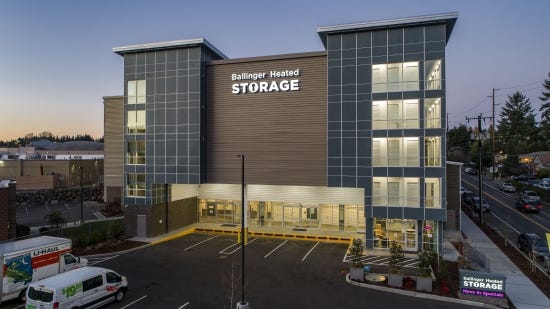The Early Stages of Self-Storage Development: Feasibility, Site Selection, Design and More
The decisions you make during the early stages of a self-storage development are critical to project success. Consider the following pointers on feasibility, site selection, design considerations and more.

In 1895, Italian economist Vilfredo Pareto noticed that 80% of Italy’s land belonged to 20% of the population. This observation led to the development of the Pareto Principle, also known as the 80/20 rule, which states that 80% of results come from 20% of the effort. This guideline applies well to self-storage development in which nearly all of the critical project decisions are made at the very beginning of the process.
Finding the right property on which to build self-storage can feel daunting, especially when multiple stakeholders and commercial interests are at play. The entitlement process then presents its own challenges. If you’re planning to build a facility, it’s important to be prepared for those difficult but crucial early stages. Consider the following pointers on feasibility, site selection, entitlements and more.
Feasibility
A design feasibility study can determine a site’s commercial potential, specifically its constraints and opportunities. This shouldn’t be confused with a demand feasibility study. The design study quantifies what can be built on a site, while the demand study concentrates on the local need for self-storage. Together these reports can help you set unit-mix targets and project the potential of the market.
Your design study should generally be followed by a formal pre-application or -submittal meeting with the jurisdiction. This meeting will allow officials to vet the conclusions stated in the reports. It’s also an important opportunity to negotiate gray areas of the local code to improve various aspects of the project. Some meetings may reveal a site to be incompatible with the developer’s vision. Though disappointing, having this realization early in the process can save you significant money and time in the long run.
Site Selection
Some of the factors that affect a property’s capacity to accommodate a successful self-storage facility include lot configuration, topography and proximity to critical environmental areas. Right-of-way dedications and accessibility can frequently impede a project. Mother Nature always governs, and any would-be developer would be wise to think about nearby wetlands and bodies of water as well as wildlife habitats, steep slopes, trees, soil geology, and potential landslides and wildfires.
Even if the natural world can accommodate your proposed project, civilization can present its own challenges. Entitlement complexity, land value and other barriers to entry are all important considerations. A property may fall under a jurisdiction with strict zoning constraints, which can restrict building size. Many municipalities use floor-area-ratio limits to curb mass. Others use height, area, impervious and lot-coverage limitations. Some even institute temporary or permanent moratoriums on self-storage for political or economic reasons.
Because the storage industry is frequently misunderstood by government agencies, parking and loading requirements for new projects can be unreasonable. If an investigation is allowed, it’s a good idea to conduct a parking study using data from the “Traffic Engineering Handbook,” by the Institute of Transportation Engineers, to demonstrate why reduced parking makes sense. Accepting the required ratios without challenge can break your efforts.
Understanding local utilities is also extremely important in the early stages of development. You need to know if there’ll be major expenses for storm-water quality or infiltration requirements, for example.

Ballinger Heated Storage in Shoreline, Washington
Design Considerations
Most jurisdictions offer some design flexibility for self-storage, but don’t make the mistake of assuming all constraints must be met per code. Fire-safety constraints, accessibility requirements and building-code interpretations vary between cities. The alternate materials and methods process also allows developers to challenge certain interpretations, and this process can pay off by averting strict readings of the code.
The building code is written to be subjectively interpreted by local officials, and they have the final say. This fact can save you money by allowing the designer to substitute alternative code elements, such as construction type, fire walls, number of stories, restroom quantity and location, enhanced communication facilities, sprinkler density, and deluge curtains.
You must also consider the self-storage tenant experience, with attention to the path a customer will follow when parking and loading, communicating with employees, obtaining a moving cart, and navigating and approaching their unit. to this core demographic. Attention to safety, wayfinding and access are important considerations, so address them as early in the design process as possible.
Team Collaboration
Once you’ve chosen and vetted a site for your self-storage project, you must assemble a development team. The goal is successful collaboration between all members: architects, engineers and general contractors as well as geotechnical, environmental, traffic and surveying consultants. The devil is in the details, and everyone must work together to find solutions for water, sanitation, street presence, air conditioning, elevators and more. It’s important to create an environment in which teamwork and open communication can thrive.
Developing a self-storage facility is complicated, especially as more communities raise their standards for safety, attractiveness and sustainability. Here’s an example of how having the right support team can help ensure project success:
In 2020, officials in Shoreline, Washington, enacted a six-month moratorium on self-storage development to evaluate the industry impact on the community. Several of my company’s clients were building there at the time. We worked with the developers and authorities to find mutually beneficial outcomes. Several design guidelines were established to allow projects to move forward, for example, a requirement for all new self-storage buildings to meet a minimum Leadership in Energy and Environmental Design certification.
While some self-storage developments seem simple, there are always unexpected hurdles. The right team of professionals can help you make critical decisions, garner community support, create synergy and ensure project success, right from those very critical early phases.
Robin Murphy is owner and principal of Jackson | Main Architecture, which has designed hundreds of self-storage facilities in rural, suburban and dense-urban areas. He’s a licensed architect in 15-plus states, with 24 years of experience in the self-storage industry. He’s a LEED-accredited professional, and member of the American Institute of Architects and the National Council of Architectural Registration Boards. To reach him, call 206.324.4800.
About the Author(s)
You May Also Like





